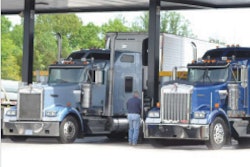Costs for trucking companies, including small carriers and owner-operators, surged in 2018, with rising fuel costs and driver wages pushing per-mile costs up 13 cents on average, according to the American Transportation Research Institute’s annual survey of carrier spending.
Combined, fuel costs and driver wages and benefits accounted for more than 66% of carriers’ per-mile expenditures in 2018, according to ATRI’s report.
Fleets spent 59.6 cents a mile on driver wages last year and 43.3 cents a mile on fuel, on average. Carriers reported spending a 18 cents a mile on driver benefits — separate from driver wages.
Fuel costs climbed 6.5 cents a mile last year on average, while spending on driver wages rose 3.9 cents a mile — 10.4 cents of the total 13-cent increase in per-mile costs.
Of survey respondents, 18% operate more than 1,000 power units, and 21% operate between 251 and 1,000 power units. A plurality of respondents (29%) operate between 26 and 100 power units; 6% operate less than 5 trucks, 15% operate between 5 and 25 trucks and 11% operate between 101 and 250 power units.
Costs of insurance premiums rose nine-tenths of a cent per mile last year, to 8.4 cents a mile on average.
Tires were the only expenditure category to not see an increase, remaining flat at 3.8 cents a mile.

Truck purchase/lease payments rose a tenth of a cent to 26.5 cents a mile. Repair and maintenance costs climbed four-tenths of a cent to 17.1 cents a mile. Spending on tolls climbed to three cents a mile, and costs for permits and licensing climbed to 2.4 cents a mile.
Since 2016, carriers’ per-mile costs have climbed more than 25 cents per mile, according to ATRI’s numbers. Costs in 2017 rose 9.9 cents from 2016, ATRI reported last year, following 2016’s 1.7-cent-per-mile increase from 2015.
Costs had dropped significantly in 2015 from 2014, but the spending hikes the past two years have pressed per-mile spending above the recent high-water marks in 2014 and 2011.
Survey respondents account for more than 125,000 power units and more than 460,000 trailers.









